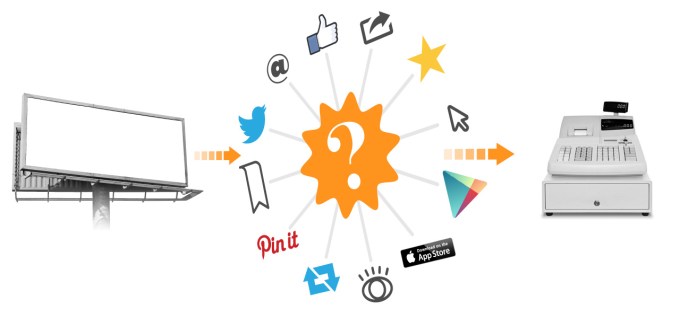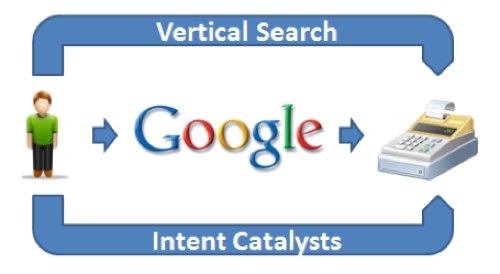Are social media companies overvalued? The question is not just a matter of revenue multiples (low or high), but rather whether that revenue is actually generating new sales for advertisers. Google convinced the world to believe in the click, Facebook has done the same with the Like, Twitter with the follower, and Pinterest is planning on unveiling the same with the Pin. Creating these “intermediate” metrics between impression and ultimate purchase is a great move to boost revenue, but must stand up to scrutiny as software eats the marketing funnel. For startups seeking to build a valuable advertising business, creating an intermediate metric is crucial, but so is ensuring that that metric holds up to scrutiny.
Let’s rewind a bit, though. Without commerce, without transactions, there would be no advertising. The point of an advertisement is to generate sales. Full stop. Brand building, goodwill, mindshare, buzz, and a lot of other niceties might come about, but even those are meant to eventually lift sales. Without a transaction at the end of the line, advertising has no raison d’être.
The challenge, though, is that it’s often difficult to draw a straight line between “person sees an advertisement” and “person buys a product.” Impression and transaction are the two endpoints of the advertising-commerce lifecycle.
And, the chronological delta between impression and purchase can be wide. A 15-year-old might be bombarded with BMW advertisements for 10 years before she finally pulls the trigger on a fancy, brand-driven car purchase. Deciding to buy Advil vs. Tylenol might take years of external inputs and supermarket trips.
Enter the intermediate metric, which is anything that falls on the continuum from impression to purchase: clicks (the Internet’s first intermediate metric), likes, bookmarks, views, shares, app downloads, recall, followers, retweets, mentions, pins, etc. Intermediate metrics help publishers (e.g., Google, Facebook, Twitter, Yelp, Pinterest, etc.) attempt to show their impact when sales are not readily measurable — either because of chronological disconnect or because the transaction data is not readily accessible. Or, cynically, and in some instances, because there are no downstream sales — making the intermediate metric the best way to obfuscate while purportedly showing performance.

Intermediate metrics help advertisers show internal and external stakeholders that they’re doing a great job. It’s hard for Clorox’s marketing team to be given an instruction of “sell 20 percent more bleach this quarter and you get a big quarterly bonus!” A national “must wear white to participate” tomato fight might increase sales of Bleach without Clorox lifting a finger. So many advertisers will compensate and reward their teams for the achievement of intermediate metrics.
- “Your goal for the quarter is to get 10 million Facebook Likes, and to get a 15 percent increase engagement on Twitter.” (This must increase sales, right?)
- “Twenty percent of your bonus this quarter will be based on getting 100,000 mobile app downloads.” (Mobile is hot and people are using mobile phones everywhere, so it must drive revenue!)
The greatest intermediate metrics allow for the broadest attribution tracking possible (accounting for marginal intent generation), while being somewhat unique to the medium. At scale, Quora might charge for a promoted corporate answer; Gmail might charge for a bolded email; Waze might charge for a “route added.” These would all be intermediate metrics, knowing that none of these actions yield an immediate purchase but hopefully contribute to one. Without an intermediate metric, there would be a publisher-advertiser marketplace failure, since immediate “transaction” tracking would undercount efficacy and cause metrics-driven advertisers to abandon the platform.
The greatest intermediate metrics allow for the broadest attribution tracking possible while being somewhat unique to the medium.
The smartest thing that Google did was charge for the click, not the sale, because it isn’t Google’s fault if your site converts poorly (or if a sale/action is not relevant, as it is for, say, auto research).
The smartest thing that Facebook did was define the like not just as an intermediate metric, but as a quantum of self-worth. Watching Samsung hit 20 million Likes must have made HTC mighty jealous and want to respond accordingly. When I asked a large restaurant chain where they spend most of their money online, the president said “Facebook. We get a lot of likes, and that must be better than not a lot of Likes.” A click — Google’s classic intermediate metric — isn’t too relevant for a restaurant that doesn’t deliver or allow online transactions. Facebook has a potentially broader audience, yet less transactional intent — so ultimately those likes will need to turn into revenue.
As Twitter goes public, it probably needs a stronger intermediate metric that can resonate with the long tail of advertisers. It might not make sense for regular people to “follow” an advertiser like Oreo in the same way they might follow their favorite moviestar, thus making followers a poor metric; in fact, The Bronx Zoo’s Cobra (an actual snake) has more followers than Oreo. The famous Oreo Superbowl tweet was retweeted only 16,000 times. The most retweeted brand advertisement on Twitter (from Nokia) has yet to top 50,000 retweets. Yet perhaps Oreo was seen by millions of people on Twitter, yielding a spike in supermarket sales, and thus followers and retweets — the intermediate metrics with which pundits seem to be measuring Twitter, are the wrong intermediate metrics.
The danger of intermediate metrics is that they feel quantitative — these are numbers, people! — but they might actually be meaningless. Ironically, both parties, advertisers and publishers, often have a vested interest in separating them from sales — for the short term — lest the music stop. Separation allows for “quantifiable metrics” when sales are just too hard to perfectly measure, so advertisers can keep spending and publishers can keep charging.
If a company’s revenue is based on selling questionable intermediate metrics, be cautious — no matter how quickly that revenue is growing. Sometimes metrics are purely about internal vanity and do not last. As an example, “number of app downloads” feels like a key performance indicator, whereas for many companies (Supercuts has an app?!), “apps” make little sense as a paradigm. Depending on how this intermediate metric (app downloads) stands up against actual incremental sales, the whole app download market could suffer. The same goes for many other intermediate metrics. When advertisers start thinking of the intermediate metric as the final action (the R in ROI = achievement of intermediate metric), the market is inflated.
For any company — whether buying traffic or selling it — intermediate metrics are often a crucial strategy in building a broad revenue model and in having a metrics-driven approach to customer acquisition and retention. But it is unwise to divorce the intermediate metric from the final, and crucial, metric of the transaction — to ignore it, or to exaggerate it, is penny wise and pound foolish. Plenty of startups and established industries (television advertising!) will be obliterated when data finally lights the path from impression to transaction and, in some cases, reveals it to be seldom traveled.

